Spatiotemporal Drought Assessment Based on Gridded Standardized Precipitation Index (SPI) in Vulnerable Agroecosystems
Abstract
1. Introduction
2. Materials and Methods
2.1. Study Area
2.2. Precipitation Data
2.3. Methodology
3. Results
3.1. Statistical and Geospatial Analysis of Drought/Wetness Severity from 1981 to 2020
3.2. Intra-Annual Geospatial Analysis of Drought/Wetness Severity from 1981 to 2020
3.3. Validation
4. Discussion
5. Conclusions
Author Contributions
Funding
Data Availability Statement
Acknowledgments
Conflicts of Interest
References
- Sheffield, J.; Wood, E.F. Projected Changes in Drought Occurrence under Future Global Warming from Multi-Model, Multi-Scenario, IPCC AR4 Simulations. Clim. Dyn. 2008, 31, 79–105. [Google Scholar] [CrossRef]
- Dai, A. Drought under Global Warming: A Review. Wiley Interdiscip. Rev. Clim. Change 2011, 2, 45–65. [Google Scholar] [CrossRef]
- IPCC. Managing the Risks of Extreme Events and Disasters to Advance Climate Change Adaptation. A Special Report of Working Groups I and II of the Intergovernmental Panel on Climate Change; Field, C.B., Barros, V., Stocker, T.F., Qin, D., Dokken, D.J., Ebi, K.L., Mastrandrea, M.D., Mach, K.J., Plattner, G.-K., Allen, S.K., et al., Eds.; Cambridge University Press: Cambridge, UK; New York, NY, USA, 2012; 582p. [Google Scholar]
- Makhlouf, B.S.I.; Khalil, S.R.A.E.; Saudy, H.S. Efficacy of humic acids and chitosan for enhancing yield and sugar quality of sugar beet under moderate and severe drought. J. Soil Sci. Plant Nutr. 2022, 22, 1676–1691. [Google Scholar] [CrossRef]
- Dalezios, N.R.; Loukas, A.; Vasiliades, L.; Liakopoulos, E. Severity-Duration-Frequency Analysis of Droughts and Wet Periods in Greece. Hydrol. Sci. J. 2000, 45, 751–769. [Google Scholar] [CrossRef]
- Hoerling, M.P.; Quan, X.W.; Eischeid, J.K.; Perlwitz, J. On the Increased Frequency of Mediterranean Drought. J. Climate 2012, 25, 2146–2161. [Google Scholar] [CrossRef]
- Williams, A.P.; Allen, C.D.; Macalady, A.K.; Griffin, D.; Woodhouse, C.A.; Meko, D.M.; Swetnam, T.W. Temperature as a Potent Driver of Regional Forest Drought Stress and Tree Mortality. Nat. Clim. Chang. 2013, 3, 292–297. [Google Scholar] [CrossRef]
- Sakellariou, S.; Cabral, P.; Caetano, M.; Pla, F.; Painho, M.; Christopoulou, O.; Sfougaris, A.; Dalezios, N.; Vasilakos, C. Remotely sensed data fusion for spatiotemporal geostatistical analysis of forest fire hazard. Sensors 2020, 20, 5014. [Google Scholar] [CrossRef] [PubMed]
- Sakellariou, S.; Sfougaris, A.; Christopoulou, O.; Tampekis, S. Integrated wildfire risk assessment of natural and anthropogenic ecosystems based on simulation modeling and remotely sensed data fusion. Int. J. Disaster Risk Reduct. 2022, 78, 103129. [Google Scholar] [CrossRef]
- Anagnostopoulou, C. A Contribution to the Drought Analysis in Greece. Ph.D. Thesis, Aristotle University of Thessaloniki, Thessaloniki, Greece, 2003. [Google Scholar]
- Caloiero, T.; Veltri, S.; Caloiero, P.; Frustaci, F. Drought Analysis in Europe and in the Mediterranean Basin Using the Standardized Precipitation Index. Water 2018, 10, 1043. [Google Scholar] [CrossRef]
- Pietrapertosa, F.; Olazabal, M.; Simoes, S.; Salvia, M.; Fokaides, P.; Ioannou, B.; Viguié, V.; Spyridaki, N.A.; De Gregorio Hurtado, S.; Geneletti, D.; et al. Adaptation to climate change in cities of Mediterranean Europe. Cities 2023, 140, 104452. [Google Scholar] [CrossRef]
- Saudy, H.S.; El–Samad, G.A.A.; El–Temsah, M.E.; El–Gabry, Y.A.E.G. Effect of iron, zinc, and manganese nano-form mixture on the micronutrient recovery efficiency and seed yield response index of sesame genotypes. J. Soil Sci. Plant Nutr. 2022, 22, 732–742. [Google Scholar] [CrossRef]
- Gao, B.C. NDWI–A normalized difference water index for remote sensing of vegetation liquid water from space. Remote Sens. Environ. 1996, 58, 257–266. [Google Scholar] [CrossRef]
- Svoboda, M.; LeComte, D.; Hayes, M.; Heim, R.; Gleason, K.; Angel, J.; Rippey, B.; Tinker, R.; Palecki, M.; Stooksbury, D.; et al. The Drought Monitor. Bull. AMS 2002, 83, 1181–1190. [Google Scholar] [CrossRef]
- González, J.; Valdés, J. New drought frequency index: Definition and comparative performance analysis. Water Resour. Res. 2006, 42, W11421. [Google Scholar] [CrossRef]
- Brown, J.F.; Wardlow, B.D.; Tadesse, T.; Hayes, J.J.; Reed, B.C. The Vegetation Drought Response Index (VegDri): An integrated approach for monitoring drought stress in vegetation. GIScience Remote Sens. 2008, 45, 16–46. [Google Scholar] [CrossRef]
- Wilhite, D.A. The role of disaster preparedness in national planning with specific reference to droughts. In Natural Disasters and Extreme Events in Agriculture; Sivakumar, M.V.K., Motha, R.P., Das, H.P., Eds.; Springer: Berlin/Heidelberg, Germany, 2005; pp. 23–37. [Google Scholar]
- Noguera, I.; Domínguez-Castro, F.; Vicente-Serrano, S.M. Characteristics and trends of flash droughts in Spain, 1961–2018. Ann. N. Y. Acad. Sci. 2020, 1472, 155–172. [Google Scholar] [CrossRef] [PubMed]
- Frischen, J.; Meza, I.; Rupp, D.; Wietler, K.; Hagenlocher, M. Drought Risk to Agricultural Systems in Zimbabwe: A Spatial Analysis of Hazard, Exposure, and Vulnerability. Sustainability 2020, 12, 752. [Google Scholar] [CrossRef]
- Mühlbauer, S.; Costa, A.C. A spatiotemporal analysis of droughts and the influence of North Atlantic Oscillation in the Iberian Peninsula based on MODIS imagery. Theor. Appl. Clim. 2015, 124, 703–721. [Google Scholar] [CrossRef]
- Vicente-Serrano, S.M.; Beguería, S.; López-Moreno, J.I. A multiscalar drought index sensitive to global warming: The standardized precipitation evapotranspiration index. J. Clim. 2010, 23, 1696–1718. [Google Scholar] [CrossRef]
- Tsakiris, G.; Vangelis, H. Establishing a Drought Index Incorporating Evapotraspiration. Eur. Water 2005, 9, 3–11. [Google Scholar]
- Bannari, A.; Morin, D.; Bonn, F.; Huete, A.R. A review of vegetation indices. Remote Sens. Rev. 1995, 13, 95–120. [Google Scholar] [CrossRef]
- Nastos, P.T.; Dalezios, N.R.; Faraslis, I.N.; Mitrakopoulos, K.; Blanta, A.; Spiliotopoulos, M.; Sakellariou, S.; Sidiropoulos, P.; Tarquis, A.M. Risk Management Framework of Environmental Hazards and Extremes in Mediterranean Ecosystems. Nat. Hazards Earth Syst. Sci. 2021, 21, 1935–1954. [Google Scholar] [CrossRef]
- WMO. World Meteorological Organization: Standardized Precipitation Index. User Guide; WMO: Geneva, Switzerland, 2012. [Google Scholar]
- Dalezios, N.R.; Blanta, A.; Spyropoulos, N.V.; Tarquis, A.M. Risk Identification of Agricultural Drought in Sustainable Agroecosystems. Nat. Hazards Earth Syst. Sci. 2014, 14, 2435–2448. [Google Scholar] [CrossRef]
- Elvidge, C.D.; Chen, Z. Comparison of broad-band and narrow-band red and near-infrared vegetation indices. Remote Sens. Environ. 1995, 54, 38–48. [Google Scholar] [CrossRef]
- Xue, J.; Su, B. Significant remote sensing vegetation indices: A review of developments and applications. J. Sens. 2017, 2017, 1353691. [Google Scholar] [CrossRef]
- Kchouk, S.; Melsen, L.A.; Walker, D.W.; Van Oel, P.R. A Geography of Drought Indices: Mismatch between Indicators of Drought and Its Impacts on Water and Food Securities. Nat. Hazards Earth Syst. Sci. 2022, 22, 323–344. [Google Scholar] [CrossRef]
- Zargar, A.; Sadiq, R.; Naser, B.; Khan, F.I. A Review of Drought Indices. Environ. Rev. 2011, 19, 333–349. [Google Scholar] [CrossRef]
- Mishra, A.K.; Singh, V.P. A Review of Drought Concepts. J. Hydrol. 2010, 391, 202–216. [Google Scholar] [CrossRef]
- McVicar, T.R.; Jupp, D.L.B. The Current and Potential Operational Uses of Remote Sensing to Aid Decisions on Drought Exceptional Circumstances in Australia: A Review. Agric. Syst. 1998, 57, 399–468. [Google Scholar] [CrossRef]
- Heim, R.R., Jr. A Review of Twentieth-Century Drought Indices Used in the United States. Bull. Am. Meteorol. Soc. 2002, 83, 1149–1165. [Google Scholar] [CrossRef]
- Keyantash, J.; Dracup, J.A. The Quantification of Drought: An Evaluation of Drought Indices. Bull. Am. Meteorol. Soc. 2002, 83, 1167–1180. [Google Scholar] [CrossRef]
- Niemeyer, S. New drought indices. Options Méditerranéennes. Série A Séminaires Méditerranéens 2008, 80, 267–274. [Google Scholar]
- Sivakumar, M.V.K.; Motha, R.P.; Wilhite, D.A.; Wood, D.A. (Eds.) Agricultural Drought Indices—Proceedings of an Expert Meeting: 2–4 June, 2010, Murcia, Spain; WMO: Geneva, Switzerland, 2011; 219p. [Google Scholar]
- Piri, J.; Abdolahipour, M.; Keshtegar, B. Advanced Machine Learning Model for Prediction of Drought Indices using Hybrid SVR-RSM. Water Resour. Manag. 2022, 37, 683–712. [Google Scholar] [CrossRef]
- Ojeda, M.G.-V.; Romero-Jiménez, E.; Rosa-Cánovas, J.J.; Yeste, P.; Castro-Díez, Y.; Esteban-Parra, M.J.; Vicente-Serrano, S.M.; Gámiz-Fortis, S.R. Assessing Future Drought Conditions over the Iberian Peninsula: The Impact of Using Different Periods to Compute the SPEI. Atmosphere 2021, 12, 980. [Google Scholar] [CrossRef]
- Arnone, E.; Cucchi, M.; Gesso, S.D.; Petitta, M.; Calmanti, S. Droughts Prediction: A Methodology Based on Climate Seasonal Forecasts. Water Resour. Manag. 2020, 34, 4313–4328. [Google Scholar] [CrossRef]
- Lai, P.; Zhang, M.; Ge, Z.; Hao, B.; Song, Z.; Huang, J.; Ma, M.; Yang, H.; Han, X. Responses of Seasonal Indicators to Extreme Droughts in Southwest China. Remote Sens. 2020, 12, 818. [Google Scholar] [CrossRef]
- del Pilar Jiménez-Donaire, M.; Tarquis, A.; Giráldez, J.V. Evaluation of a combined drought indicator and its predictive potential for agricultural droughts in Southern Spain. Nat. Hazards Earth Syst. Sci. Discuss 2019, 20, 21–33. [Google Scholar] [CrossRef]
- Habibi, B.; Meddi, M.; Torfs, P.J.; Remaoun, M.; Van Lanen, H.A. Characterisation and prediction of meteorological drought using stochastic models in the semi-arid Chéliff–Zahrez basin (Algeria). J. Hydrol. Reg. Stud. 2018, 16, 15–31. [Google Scholar] [CrossRef]
- Tian, M.; Wang, P.; Khan, J. Drought Forecasting with Vegetation Temperature Condition Index Using ARIMA Models in the Guanzhong Plain. Remote Sens. 2016, 8, 690. [Google Scholar] [CrossRef]
- Das, P.K.; Dutta, D.; Sharma, J.R.; Dadhwal, V.K. Trends and behaviour of meteorological drought (1901–2008) over Indian region using standardized precipitation–evapotranspiration index. Int. J. Climatol. 2015, 36, 909–916. [Google Scholar] [CrossRef]
- AghaKouchak, A.; Farahmand, A.; Melton, F.S.; Teixeira, J.; Anderson, M.C.; Wardlow, B.D.; Hain, C.R. Remote sensing of drought: Progress, challenges, and opportunities. Rev. Geophys. 2015, 53, 452–480. [Google Scholar] [CrossRef]
- Spiliotopoulos, M.; Loukas, A. Hybrid Methodology for the Estimation of Crop Coefficients Based on Satellite Imagery and Ground-Based Measurements. Water 2019, 11, 1364. [Google Scholar] [CrossRef]
- Domenikiotis, C.; Spiliotopoulos, M.; Tsiros, E.; Dalezios, N.R. Early cotton production assessment in Greece based on the combination of the drought vegetation condition index (VCI) and Bhalme and Mooley Drought Index (BMDI). Int. J. Remote Sens. 2004, 25, 5373–5388. [Google Scholar] [CrossRef]
- Domenikiotis, C.; Spiliotopoulus, M.; Tsiros, E.; Dalezios, N.R. Early cotton yield assessment by the use of the NOAA/AVHRR derived vegetation condition index (VCI) in Greece. Int. J. Remote Sens. 2004, 25, 2807–2819. [Google Scholar] [CrossRef]
- McKee, T.B.; Doesken, N.J.; Kleist, J. The relationship of drought frequency and duration to time scales. In Proceedings of the 8th Conference on Applied Climatology, Anaheim, CA, USA, 17–22 January 1993; American Meteorological Society: Boston, MA, USA, 1993; pp. 179–184. [Google Scholar]
- Guttman, N.B. On the sensitivity of sample L moments to sample size. J. Clim. 1994, 7, 1026–1029. [Google Scholar] [CrossRef]
- Hayes, M.J.; Svoboda, M.D. Monitoring the 1996 drought using the standardized precipitation index. Bull. Am. Meteorol. Soc. 1999, 80, 429–438. [Google Scholar] [CrossRef]
- Merabti, A.; Martins, D.S.; Meddi, M.; Pereira, L.S. Spatial and time variability of drought based on SPI and RDI with various time scales. Water Resour. Manag. 2018, 32, 1087–1100. [Google Scholar] [CrossRef]
- Merabti, A.; Darouich, H.; Paredes, P.; Meddi, M.; Pereira, L.S. Assessing Spatial Variability and Trends of Droughts in Eastern Algeria Using SPI, RDI, PDSI, and MedPDSI—A Novel Drought Index Using the FAO56 Evapotranspiration Method. Water 2023, 15, 626. [Google Scholar] [CrossRef]
- Stathi, E.; Kastridis, A.; Myronidis, D. Analysis of Hydrometeorological Characteristics and Water Demand in Semi-Arid Mediterranean Catchments under Water Deficit Conditions. Climate 2023, 11, 137. [Google Scholar] [CrossRef]
- Tsakiris, G.; Vangelis, H. Towards a Drought Watch System Based on Spatial SPI. Water Resour. Manag. 2004, 18, 1–12. [Google Scholar] [CrossRef]
- Livada, I.; Assimakopoulos, V.D. Spatial and Temporal Analysis of Drought in Greece Using the Standardized Precipitation Index (SPI). Appl. Clim. 2007, 89, 143–153. [Google Scholar] [CrossRef]
- Anagnostopoulou, C. Future Drought Projection for the Greek Region. Bull. Geol. Soc. Greece 2017, 50, 1038. [Google Scholar] [CrossRef][Green Version]
- Paparrizos, S.; Maris, F.; Weiler, M.; Matzarakis, A. Analysis and Mapping of Present and Future Drought Conditions over Greek Areas with Different Climate Conditions. Appl. Clim. 2018, 131, 259–270. [Google Scholar] [CrossRef]
- Georgoulias, A.K.; Akritidis, D.; Kalisoras, A.; Kapsomenakis, J.; Melas, D.; Zerefos, C.S.; Zanis, P. Climate Change Projections for Greece in the 21st Century from High-Resolution EURO-CORDEX RCM Simulations. Atmos. Res. 2022, 271, 106049. [Google Scholar] [CrossRef]
- Politi, N.; Vlachogiannis, D.; Sfetsos, A.; Nastos, P.T.; Dalezios, N.R. High Resolution Future Projections of Drought Characteristics in Greece Based on SPI and SPEI Indices. Atmosphere 2022, 13, 1468. [Google Scholar] [CrossRef]
- Kourgialas, N. Hydroclimatic impact on mediterranean tree crops area–Mapping hydrological extremes (drought/flood) prone parcels. J. Hydrol. 2021, 596, 125684. [Google Scholar] [CrossRef]
- Golia, E.E.; Diakoloukas, V. Soil Parameters Affecting the Levels of Potentially Harmful Metals in Thessaly Area, Greece: A Robust Quadratic Regression Approach of Soil Pollution Prediction. Environ. Sci. Pollut. Res. 2022, 29, 29544–29561. [Google Scholar] [CrossRef] [PubMed]
- Climate Hazards Center. CHIRPS: Rainfall Estimates from Rain Gauge and Satellite Observations. 2022. Available online: https://www.chc.ucsb.edu/data/chirps (accessed on 28 September 2022).
- Duan, Z.; Liu, J.; Tuo, Y.; Chiogna, G.; Disse, M. Evaluation of Eight High Spatial Resolution Gridded Precipitation Products in Adige Basin (Italy) at Multiple Temporal and Spatial Scales. Sci. Total Environ. 2016, 573, 1536–1553. [Google Scholar] [CrossRef]
- Qin, Y.; Yang, D.; Lei, H.; Xu, K.; Xu, X. Comparative Analysis of Drought Based on Precipitation and Soil Moisture Indices in Haihe Basin of North China during the Period of 1960–2010. J. Hydrol. 2015, 526, 55–67. [Google Scholar] [CrossRef]
- Steinemann, A. Drought indicators and triggers: A stochastic approach to evaluation. JAWRA J. Am. Water Resour. Assoc. 2003, 39, 1217–1233. [Google Scholar] [CrossRef]
- Guttman, N.B. Accepting the Standardized Precipitation Index: A Calculation Algorithm 1. JAWRA J. Am. Water Resour. Assoc. 1999, 35, 311–322. [Google Scholar] [CrossRef]
- Sidiropoulos, P.; Dalezios, N.R.; Loukas, A.; Mylopoulos, N.; Spiliotopoulos, M.; Faraslis, I.N.; Alpanakis, N.; Sakellariou, S. Quantitative Classification of Desertification Severity for Degraded Aquifer Based on Remotely Sensed Drought Assessment. Hydrology 2021, 8, 47. [Google Scholar] [CrossRef]
- EDO. European Drought Observatory. 2021. Available online: https://edo.jrc.ec.europa.eu/documents/factsheets/factsheet_spi.pdf (accessed on 30 June 2021).
- Ayub, M.; Ashraf, M.Y.; Kausar, A.; Saleem, S.; Anwar, S.; Altay, V.; Ahmad, S.; Ali, S.; Ahmad, R.; Ahmad, R.; et al. Growth and Physio–Biochemical Responses of Maize (Zea mays L.) to Drought and Heat Stresses. Plant Biosyst. 2021, 155, 535–542. [Google Scholar] [CrossRef]
- Loukas, A.; Vasiliades, L.; Tzabiras, J. Evaluation of climate change on drought impulses in Thessaly, Greece. Eur. Water 2007, 17, 17–28. Available online: https://www.ewra.net/ew/pdf/EW_2007_17-18_02.pdf (accessed on 20 February 2023).
- Aurenhammer, F.; Klein, R.; Lee, D.T. Voronoi Diagrams and Delaunay Triangulations; World Scientific Publishing Company: Singapore, 2013; ISBN 978-981-4449-55-5. [Google Scholar]
- Chicco, D.; Warrens, M.J.; Jurman, G. The coefficient of determination R-squared is more informative than SMAPE, MAE, MAPE, MSE and RMSE in regression analysis evaluation. PeerJ Comput. Sci. 2021, 7, e623. [Google Scholar] [CrossRef]
- Loukas, A.; Vasiliades, L. Probabilistic analysis of drought spatiotemporal characteristics in Thessaly Region, Greece. Nat. Hazards Earth Syst. Sci. 2004, 4, 719–731. [Google Scholar] [CrossRef]
- Karavitis, C.A.; Alexandris, S.; Tsesmelis, D.E.; Athanasopoulos, G. Application of the Standardized Precipitation Index (SPI) in Greece. Water 2011, 3, 787–805. [Google Scholar] [CrossRef]
- Kourtis, I.M.; Vangelis, H.; Tigkas, D.; Mamara, A.; Nalbantis, I.; Tsakiris, G.; Tsihrintzis, V.A. Drought Assessment in Greece Using SPI and ERA5 Climate Reanalysis Data. Sustainability 2023, 15, 15999. [Google Scholar] [CrossRef]
- Vasiliades, L. Drought Spatiotemporal Analysis, Modelling and Forecasting in Pinios River Basin of Thessaly, Greece. Ph.D. Thesis, University of Thessaly, Volos, Greece, 2010. Available online: http://hdl.handle.net/10442/hedi/22285 (accessed on 1 November 2023).
- Blanta, A.; and Spyropoulos, N.V. Assessment of remotely sensed drought features in vulnerable agriculture. Nat. Hazards Earth Syst. Sci. 2012, 12, 3139–3150. [Google Scholar] [CrossRef]
- Logar, I.; van den Bergh, J.C.J.M. Methods to Assess Costs of Drought Damages and Policies for Drought Mitigation and Adaptation: Review and Recommendations. Water Resour. Manage. 2013, 27, 1707–1720. [Google Scholar] [CrossRef]
- Pincheira, M.; Vecchio, M.; Giaffreda, R.; Kanhere, S.S. Cost-effective IoT devices as trustworthy data sources for a blockchain-based water management system in precision agriculture. Comput. Electron. Agric. 2021, 180, 105889. [Google Scholar] [CrossRef]
- Bwambale, E.; Abagale, F.K.; Anornu, G.K. Smart irrigation monitoring and control strategies for improving water use efficiency in precision agriculture: A review. Agric. Water Manag. 2022, 260, 107324. [Google Scholar] [CrossRef]
- Kamienski, C.; Soininen, J.P.; Taumberger, M.; Dantas, R.; Toscano, A.; Salmon Cinotti, T.; Filev Maia, R.; Torre Neto, A. Smart water management platform: IoT-based precision irrigation for agriculture. Sensors 2019, 19, 276. [Google Scholar] [CrossRef] [PubMed]
- Jayalakshmi, M.; Gomathi, V. Sensor-cloud based precision agriculture approach for intelligent water management. Int. J. Plant Prod. 2020, 14, 177–186. [Google Scholar] [CrossRef]
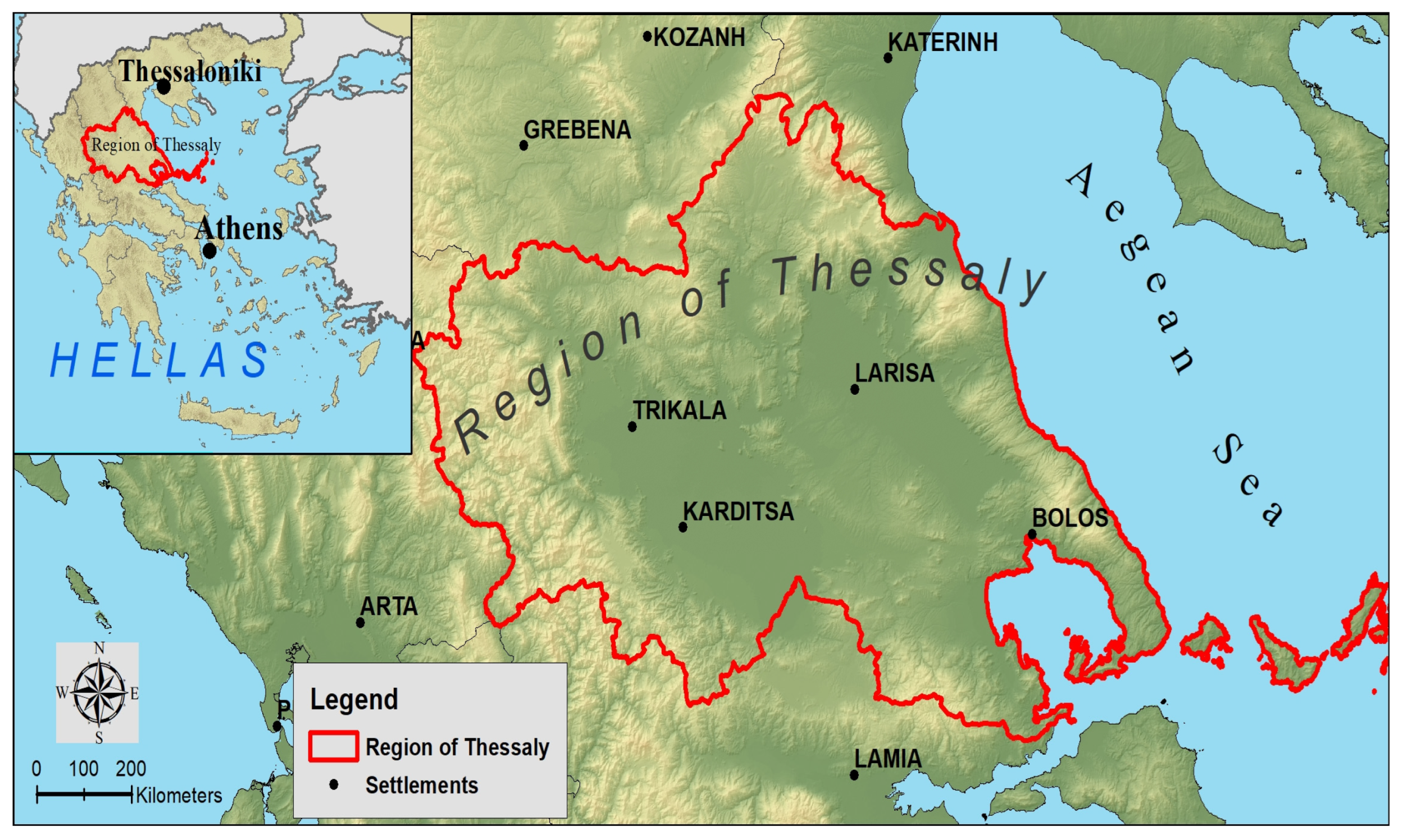
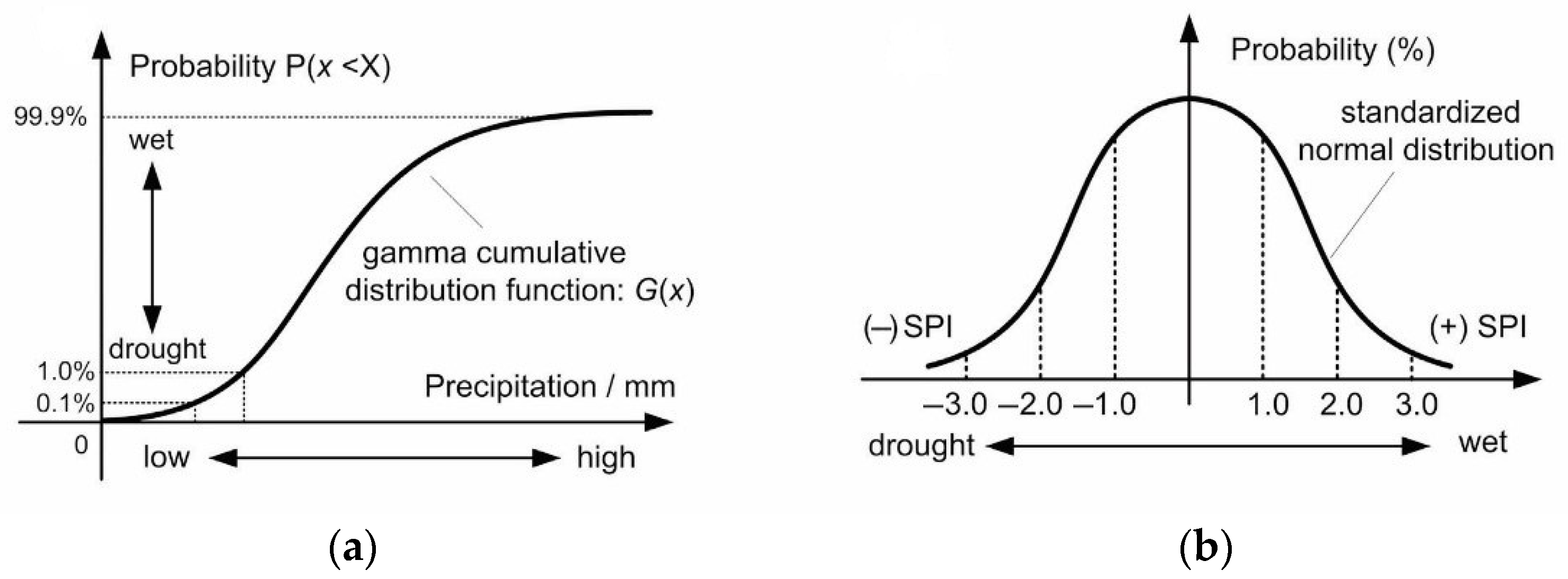
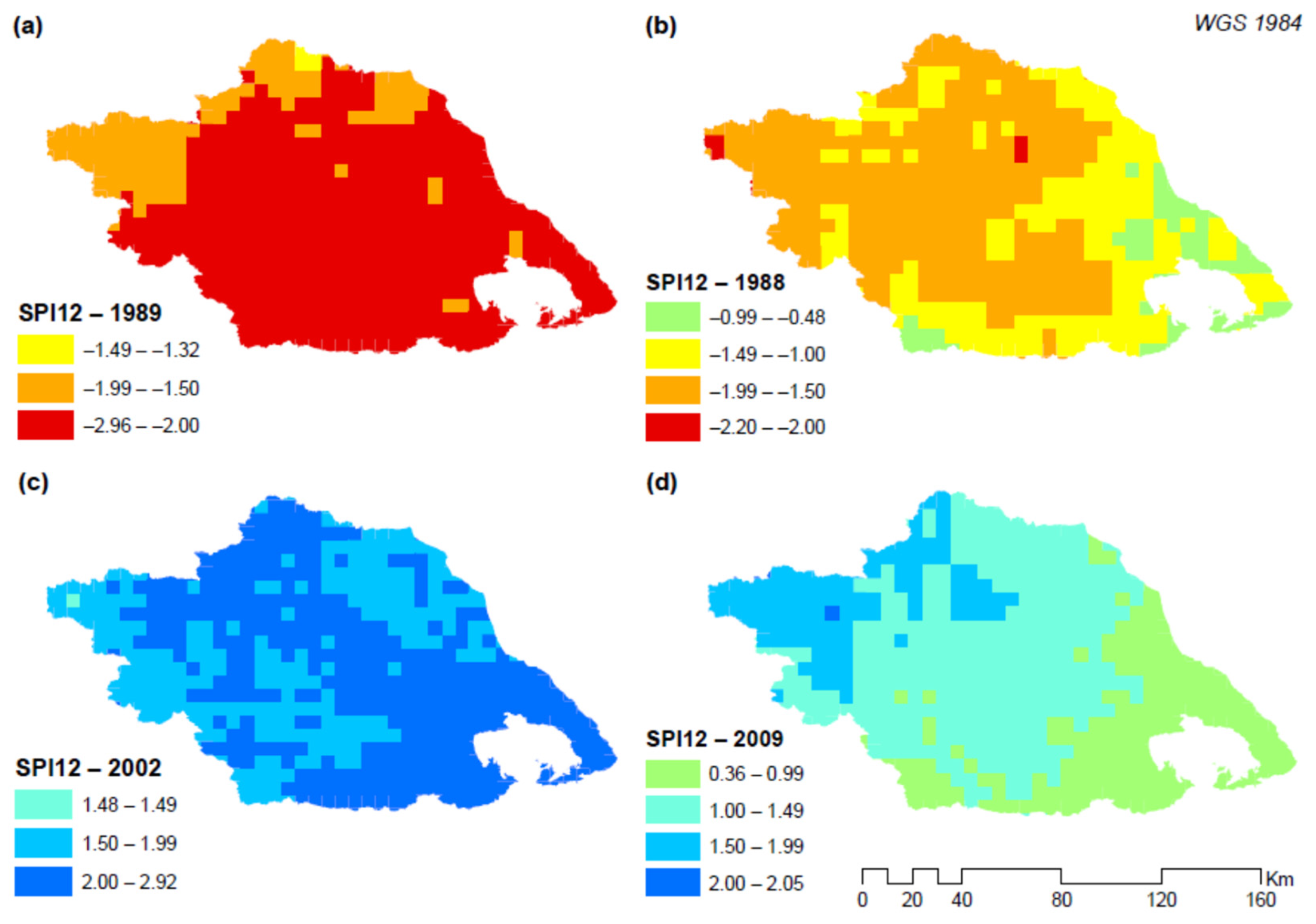
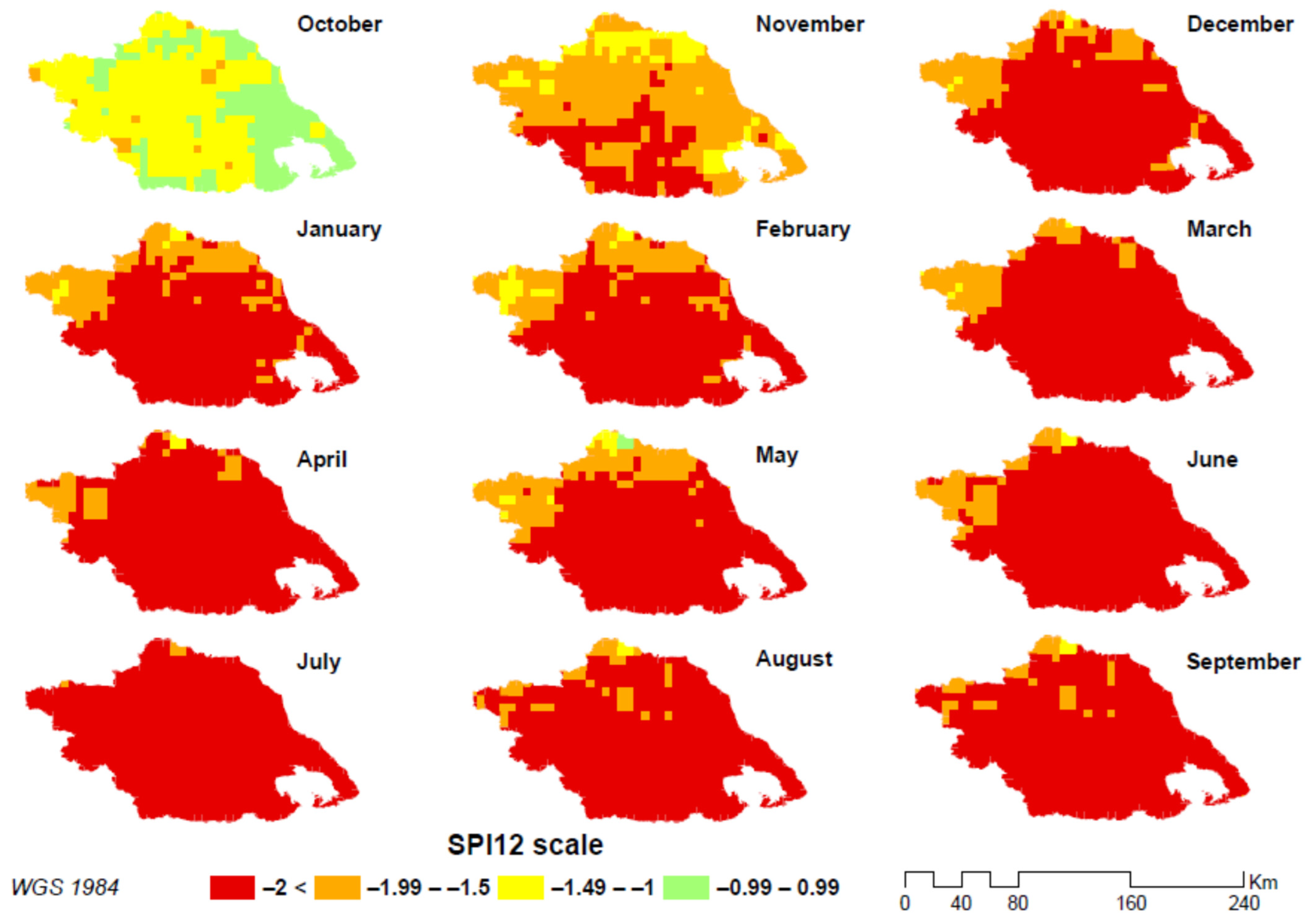
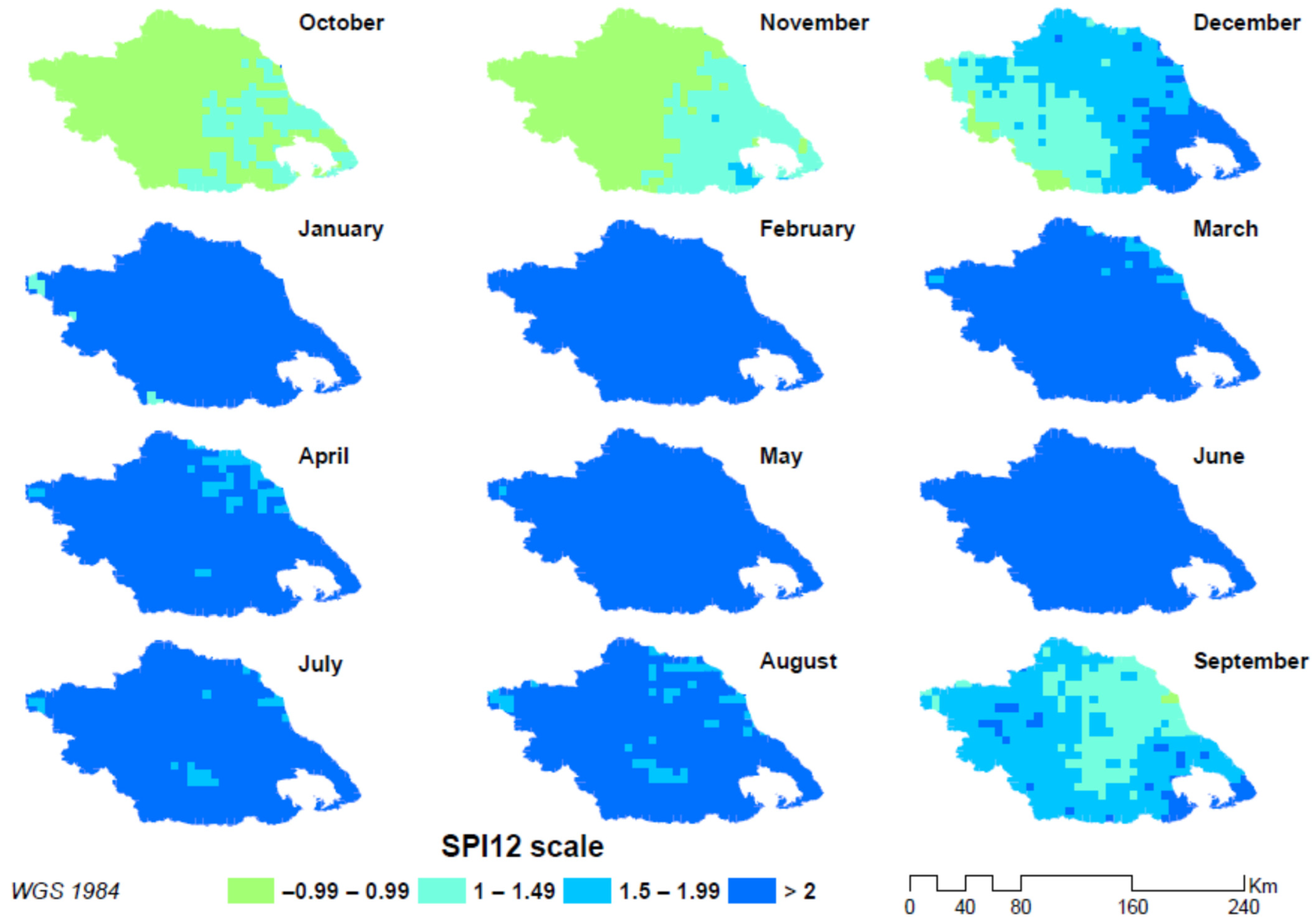
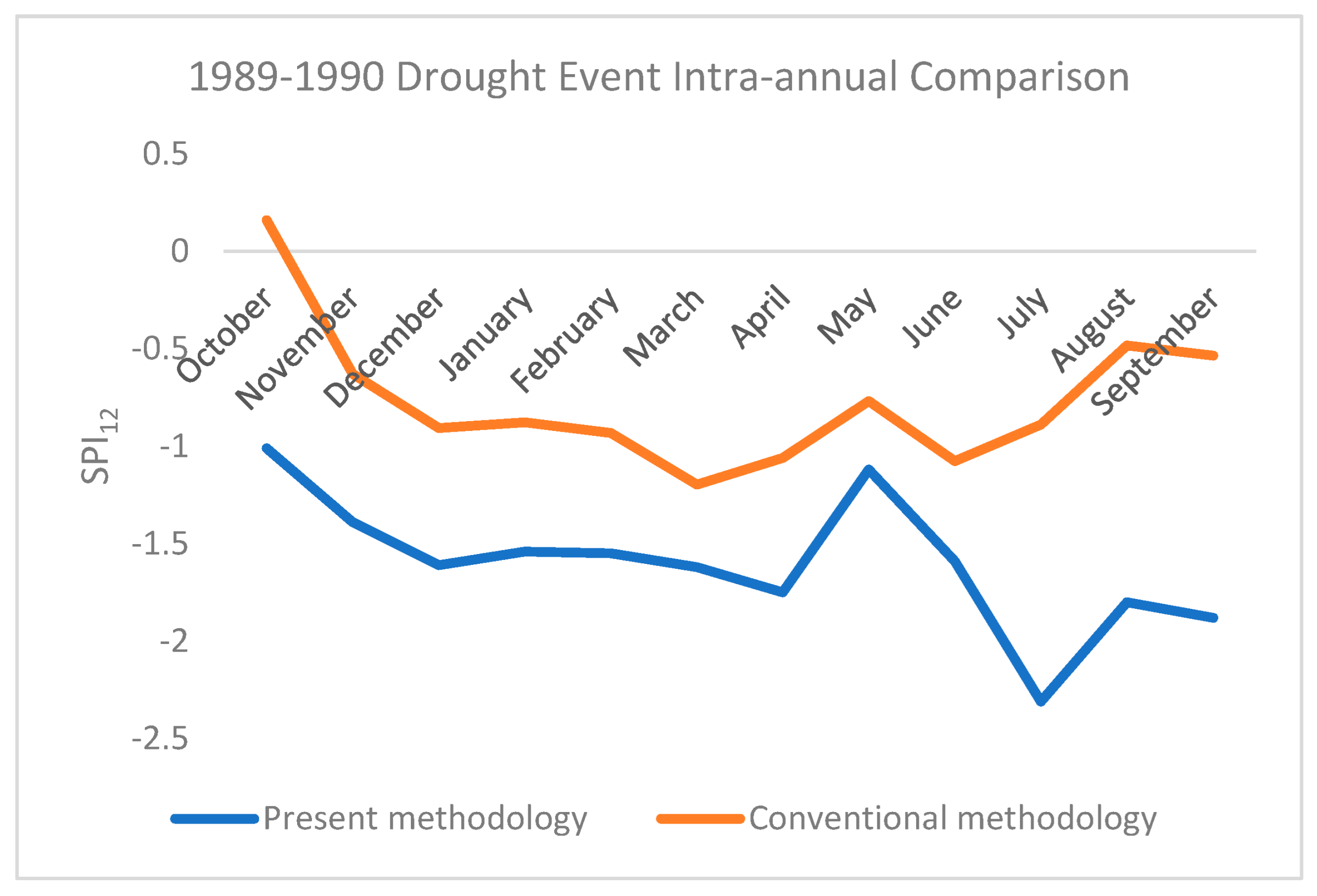
| SPI Values | Class | Probability (%) |
|---|---|---|
| >2 | Extremely wet | 2.3 |
| 1.5–1.99 | Very wet | 4.4 |
| 1–1.49 | Moderately wet | 9.2 |
| −0.99–0.99 | Normal precipitation | 68.2 |
| −1–−1.49 | Moderately dry | 9.2 |
| −1.5–−1.99 | Very dry | 4.4 |
| <−2 | Extremely dry | 2.3 |
| Hydrological Year (Oct.–Sep.) | Mean | Hydrological Year (Oct.–Sep.) | Mean |
|---|---|---|---|
| 1982 | 0.404 | 2002 | 2.077 |
| 1983 | 0.42 | 2003 | 0.961 |
| 1984 | −0.518 | 2004 | −0.144 |
| 1985 | −0.225 | 2005 | −0.065 |
| 1986 | −0.283 | 2006 | −0.082 |
| 1987 | −0.116 | 2007 | −0.538 |
| 1988 | −1.462 | 2008 | 0.472 |
| 1989 | −2.266 | 2009 | 1.15 |
| 1990 | −0.222 | 2010 | 0.631 |
| 1991 | −0.57 | 2011 | −0.525 |
| 1992 | −0.936 | 2012 | 0.812 |
| 1993 | −0.346 | 2013 | −0.228 |
| 1994 | 0.617 | 2014 | 0.723 |
| 1995 | 0.509 | 2015 | 0.178 |
| 1996 | 0.219 | 2016 | −0.419 |
| 1997 | −0.124 | 2017 | 0.432 |
| 1998 | 1.142 | 2018 | 0.297 |
| 1999 | −0.28 | 2019 | −0.009 |
| 2000 | −1.25 | 2020 | 0.236 |
| 2001 | −0.764 |
| Year | Month | Normal Conditions | Moderate Drought | Severe Drought | Extreme Drought |
|---|---|---|---|---|---|
| 1989 | October | 36% | 60% | 4% | 0% |
| 1989 | November | 0% | 15% | 60% | 25% |
| 1989 | December | 0% | 1% | 21% | 78% |
| 1990 | January | 0% | 2% | 26% | 72% |
| 1990 | February | 0% | 4% | 25% | 71% |
| 1990 | March | 0% | 1% | 16% | 83% |
| 1990 | April | 0% | 0% | 11% | 89% |
| 1990 | May | 1% | 2% | 23% | 74% |
| 1990 | June | 0% | 1% | 14% | 85% |
| 1990 | July | 0% | 0% | 1% | 99% |
| 1990 | August | 0% | 1% | 9% | 90% |
| 1990 | September | 0% | 1% | 9% | 90% |
| Year | Month | Normal Conditions | Moderate Wet | Very Wet | Extremely Wet |
|---|---|---|---|---|---|
| 2002 | October | 77% | 22% | 1% | 0% |
| 2002 | November | 64% | 32% | 3% | 1% |
| 2002 | December | 8% | 27% | 43% | 22% |
| 2003 | January | 0% | 0% | 2% | 98% |
| 2003 | February | 0% | 0% | 0% | 100% |
| 2003 | March | 0% | 0% | 4% | 96% |
| 2003 | April | 0% | 0% | 8% | 92% |
| 2003 | May | 0% | 0% | 0% | 100% |
| 2003 | June | 0% | 0% | 0% | 100% |
| 2003 | July | 0% | 0% | 4% | 96% |
| 2003 | August | 0% | 0% | 9% | 91% |
| 2003 | September | 1% | 27% | 61% | 11% |
| Location | Χ | Y | R2 |
|---|---|---|---|
| Kalampaka | 296,882.00 | 4,396,738.00 | 0.64 |
| Kapnikos | 320,334.96 | 4,357,401.22 | 0.74 |
| Karditsomagoyla | 320,420.33 | 4,361,100.99 | 0.66 |
| Larisa | 363,919.00 | 4,387,859.00 | 0.65 |
| Morfovouni | 305,915.00 | 4,357,630.00 | 0.64 |
| Trikala | 307,901.00 | 4,379,795.00 | 0.66 |
| Xalkiades | 363,597.53 | 4,361,486.00 | 0.62 |
| Zappeio | 366,461.00 | 4,369,310.00 | 0.72 |
Disclaimer/Publisher’s Note: The statements, opinions and data contained in all publications are solely those of the individual author(s) and contributor(s) and not of MDPI and/or the editor(s). MDPI and/or the editor(s) disclaim responsibility for any injury to people or property resulting from any ideas, methods, instructions or products referred to in the content. |
© 2024 by the authors. Licensee MDPI, Basel, Switzerland. This article is an open access article distributed under the terms and conditions of the Creative Commons Attribution (CC BY) license (https://creativecommons.org/licenses/by/4.0/).
Share and Cite
Sakellariou, S.; Spiliotopoulos, M.; Alpanakis, N.; Faraslis, I.; Sidiropoulos, P.; Tziatzios, G.A.; Karoutsos, G.; Dalezios, N.R.; Dercas, N. Spatiotemporal Drought Assessment Based on Gridded Standardized Precipitation Index (SPI) in Vulnerable Agroecosystems. Sustainability 2024, 16, 1240. https://doi.org/10.3390/su16031240
Sakellariou S, Spiliotopoulos M, Alpanakis N, Faraslis I, Sidiropoulos P, Tziatzios GA, Karoutsos G, Dalezios NR, Dercas N. Spatiotemporal Drought Assessment Based on Gridded Standardized Precipitation Index (SPI) in Vulnerable Agroecosystems. Sustainability. 2024; 16(3):1240. https://doi.org/10.3390/su16031240
Chicago/Turabian StyleSakellariou, Stavros, Marios Spiliotopoulos, Nikolaos Alpanakis, Ioannis Faraslis, Pantelis Sidiropoulos, Georgios A. Tziatzios, George Karoutsos, Nicolas R. Dalezios, and Nicholas Dercas. 2024. "Spatiotemporal Drought Assessment Based on Gridded Standardized Precipitation Index (SPI) in Vulnerable Agroecosystems" Sustainability 16, no. 3: 1240. https://doi.org/10.3390/su16031240
APA StyleSakellariou, S., Spiliotopoulos, M., Alpanakis, N., Faraslis, I., Sidiropoulos, P., Tziatzios, G. A., Karoutsos, G., Dalezios, N. R., & Dercas, N. (2024). Spatiotemporal Drought Assessment Based on Gridded Standardized Precipitation Index (SPI) in Vulnerable Agroecosystems. Sustainability, 16(3), 1240. https://doi.org/10.3390/su16031240











